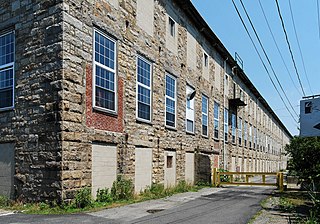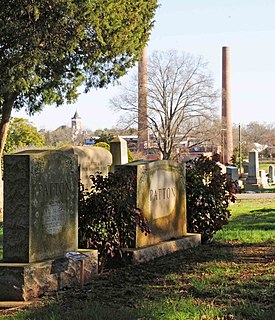
Rock Hill is the largest city in York County, South Carolina, United States and the fifth-largest city in the state. It is also the fourth-largest city of the Charlotte metropolitan area, behind Charlotte, Concord, and Gastonia. As of the 2010 Census, the population was 66,154. In 2019, the population had increased to 75,048. As of 2017, the total population of the Rock Hill Census County Division was estimated at 117,375 people.

Saylesville is a village and historic district in Lincoln, Rhode Island.

Fall River Bleachery is an historic textile bleachery on Jefferson Street in Fall River, Massachusetts.

Southern Bleachery and Print Works is a historic factory building in Taylors, Greenville County, South Carolina. Founded by former Furman University English professor Bennette Geer, and built by the J. E. Sirrine Company of Greenville, the mill operated between 1924 and 1965, with the last historic structure being built in 1952. The property consists of 15 contributing resources, including a main building, warehouses, a smokestack, a detached boiler room with smokestack, a filtration plant, and two ponds. The bleachery acquired unfinished goods produced by other textile mills and converted them by bleaching, dyeing, and finishing into material used to manufacture clothing and other items. A small mill village, including Baptist and Methodist churches, was established nearby, and many mill houses continued to exist into the 21st century.

McCorkle-Fewell-Long House is a historic home located at Rock Hill, South Carolina. It was built prior to 1821, and extensively rebuilt about 1880, incorporating Queen Anne style elements. It is a two-story, five bay dwelling of heavy timber frame construction sheathed with weatherboard and flushboard siding. It features a full-width front porch with square columns and decorative scrollwork. Located to the rear of the house is the former carriage house.

Stokes-Mayfield House is a historic home located at Rock Hill, South Carolina. It was built in 1907, and is a two-story, frame residence with cross-gabled slate roof in the Neo-Classical style. The house features a two-story tetrastyle Corinthian order pedimented portico and a balcony with decorative iron brackets above the front door.

Ebenezer Academy is a historic school building located at Rock Hill, South Carolina. It was built about 1860, and is a one-story, rectangular brick structure of simple design. The school was originally associated with Ebenezer Presbyterian Church until Rock Hill public schools were established about 1888 and was leased to York County for an elementary school. The school continued until 1950 when it was deeded back to the church. It is the oldest known school building standing in York County.

Tillman Hall, originally known as Main Building, is a historic academic building located on the campus of Winthrop University at Rock Hill, South Carolina. It was built in 1894, and is a three-story, red brick building in the Richardsonian Romanesque style. The building includes a basement and attic, has a combination gabled and hipped roof configuration, projecting bay windows, and features a conical-roofed clock tower with open belfry. In 1962, Main Building was renamed Tillman Hall for Governor, Democratic U.S. Senator, and avowed white supremacist Benjamin Tillman. Tillman Hall's Auditorium has hosted concerts by Frankie Valli and the Four Seasons in 1970, Jars of Clay in 1997, Florida's metal band Trivium in 2005, Celtic rock band Seven Nations in 2005, Recycled Percussion in 2007, and pop folk pianist Vienna Teng in 2008. The 2008 direct-to-video horror film Asylum was filmed outside of and inside Tillman Hall. The ending of the 1999 horror film Carrie 2 was filmed at Tillman Hall.

Afro-American Insurance Company Building is a historic commercial building located at Rock Hill, South Carolina. It was built about 1909, and is a two-story, brick commercial building. The façade has a tan brick veneer, while the sides and rear are in red brick. It is an important surviving example of a commercial building related to the African-American community of the early-20th century.

People's National Bank Building, also known as Franklin's Clothing Store, is a historic bank building located at Rock Hill, South Carolina. It was built about 1909–1910, and is a four-story brick building, plus basement. It was the first building in the city constructed as a speculative office building, the first with a passenger elevator, and the tallest commercial building in Rock Hill. The People's National Bank merged with Citizens and Southern National Bank of South Carolina in 1964 and moved out of the building in 1972.

Rock Hill Body Company, originally known as Victoria Yarn Mill # 2, is a historic industrial building located at Rock Hill, South Carolina. It was built about 1915, and is a two-story brick industrial building built as a textile mill. Later modifications include a one-story office addition and an elevator tower addition on the rear. It was the home of the Rock Hill Body Company, one of the earliest makers of truck bodies and school bus bodies in South Carolina, from 1938 to 1986.

Rock Hill Cotton Factory, also known as Plej's Textile Mill Outlets, Ostrow Textile Mill, and Fewell Cotton Warehouse, is a historic textile mill complex located at Rock Hill, South Carolina. The mill was built in 1881, and is a two-story, 12 bay by 16 bay, brick factory. It features a three-story tower at the main entrance. A number of additions have been made to the building. The Fewell Cotton Warehouse is a one-story, brick and wood frame warehouse built before 1894.

Laurelwood Cemetery is a historic cemetery located at Rock Hill, South Carolina. It was established in 1872, and was the first municipal cemetery of Rock Hill. It contains over 11,414 marked grave sites and includes variety of funerary art including a few raised stone tombs and a number of obelisks, table markers, spheres, and other forms. The cemetery also includes a Confederate monument and a memorial to veterans of the World War I.

Winthrop College Historic District is a national historic district located on the campus of Winthrop University at Rock Hill, South Carolina. It encompasses 17 contributing buildings and 1 contributing structure constructed between 1894 and 1943. Architectural styles represented include Gothic Revival, Richardsonian Romanesque, Classical Revival, and Colonial Revival. Notable buildings include the separately listed Tillman Hall and Withers Building, as well as Alumni House, Phelps Dormitory, Thurmond Building, Byrnes Auditorium, Johnson Hall, and the President's Residence.

Marion Street Area Historic District is a national historic district located at Rock Hill, South Carolina. It encompasses 28 contributing buildings and 1 contributing site in a middle-class residential section of Rock Hill. The bulk of the district developed between 1906 and 1925. Architectural styles represented include Victorian, Classical Revival, Colonial Revival, and Bungalow. Notable buildings include the Rawlinson House, McCall-Jones-Byrant House, Davis House, and W. B. Jenkins House.

Reid Street–North Confederate Avenue Area Historic District is a national historic district located at Rock Hill, South Carolina. It encompasses 22 contributing buildings in a middle-class residential section of Rock Hill. The district developed between about 1839 and 1935. Architectural styles represented include Victorian, Classical Revival, Queen Anne, and Bungalow. Notable buildings include the Steed House, Bynum House, Jenkins House, and Gross-Brock House, along with the separately listed White House.

Charlotte Avenue–Aiken Avenue Historic District is a national historic district located at Rock Hill, South Carolina. It encompasses seven contributing dwellings in the Oakland section of Rock Hill. The district developed between about 1891 and 1935. Architectural styles represented include Classical Revival, Queen Anne, and Bungalow. Contributing buildings are the Hughes Walker House, Paul D. Farris House, Roy Z. Thomas House, Wilson House, Armstrong-Mauldin House, and Bays-Blackman House.

Highland Park Manufacturing Plant and Cotton Oil Complex is a historic industrial complex and national historic district located at Rock Hill, South Carolina. It encompasses three contributing building and two contributing structures in Rock Hill. The complex includes the Highland Park Manufacturing Plant, the Highland Park Cotton Oil Mill (1902), and the Highland Park Cotton Oil Mill Office (1902). They are the surviving buildings of a larger complex, including a gin and seed house, the rest of which have been demolished. Surrounding the original mill are portions of the mill village. The mill operated until 1968.

Nation Ford Fish Weir is a historic fishing weir located near Rock Hill, South Carolina. It is one of the few relatively intact Native American fish weirs remaining in South Carolina. It is a double "V"-shaped rock fish trap or weir located in the channel of the Catawba River upstream from the railroad trestle at Nation Ford. The weir is located near the Nation Ford Road crossing point of the river and to several documented Catawba people villages.

The Rock Hill Printing and Finish Company, also known locally as The Bleachery is a historic textile processing facility at 400 West White Street in downtown Rock Hill, South Carolina. The complex consists of six buildings dating as far back as 1925, as well as a reservoir, and employed nearly 5,000 workers at its height in 1965.






















